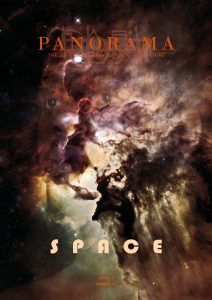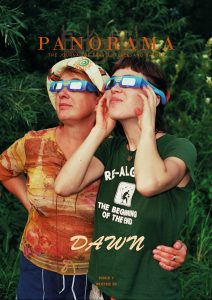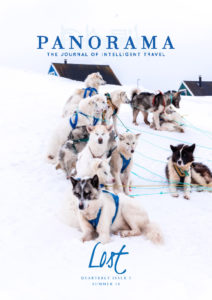About a year before I was born, my parents and six-year-old sister moved into a house in southern Brooklyn, in a neighbourhood that is often cut off of tourist maps. The semi-attached house has a faded lime green exterior with a red-shingled roof, as if the architect wanted the house to be festive, but not overly so. The house number above the doorway is small and not that easy to spot, and so I have told friends to ring the doorbell of the green house with the red roof. But I’ve had friends who accidentally rang a neighbour’s doorbell thinking that they’d found the right place.
I should have told them to ring the doorbell of the house closest to the smallest tree. My father had a sycamore planted in front of the house by the curb soon after my family settled in. It has grown significantly since it was planted, however it still seems tiny compared with the much older sycamores on the block. I was born the same year that the tree was planted, and so I’ve thought of it as my tree twin.
The interior of the house has changed over the years. A dark orange carpet was removed and replaced by wooden floors and the eggshell-hued walls were painted a light sea green colour. My father would bring home bookcases that needed new homes from yard sales. My family installed a small lift on the side of the staircase after I became paralyzed at age 16 and could no longer climb stairs. They also had a ramp built in the backyard so that I could wheel into the house. Our neighbours, who had recently emigrated from Albania, built the ramp for free.
My neighbourhood has become a diverse mix of Italian, Irish, Middle-Eastern, Scandinavian, Hispanic and Asian cultures, including my own Italian-American-Taiwanese household. Any given day, I can wander down a street and hear Arabic, Spanish, or Korean, in addition to English. Parents of various backgrounds shop at the same bodegas and attempt to control their wandering children. At least one member of almost every ethnic group in my neighbourhood has set up some sort of bakery, so children have an enviable range of sweets to choose from if a parent decides to bribe them in exchange for good behaviour. Although I do not understand a word they say to their children, I enjoy the blend of sounds.
My street is mostly residential, save for a few shops and restaurants on the corners of certain blocks. There is a mix of two-family houses, semi-attached houses, houses with driveways, and apartment buildings. As you travel from my house down towards the Narrows – the body of water under the Verrazano-Narrows Bridge – you encounter large houses with multiple staircases, or single staircases of grand lengths, and garages that can hold more than two cars. My street is one of many in a grid, and the casual observer would not be able to tell it apart from other parallel streets nearby.
*****
My mother’s father traveled from Taiwan to visit my family every four or five years, and stayed with us in Brooklyn. Of his five children, my mother was his only child to move to America, which meant that he spent significantly less time with my sister and me than with his other grandchildren. He usually visited in the summer, when school was out. My sister, who is seven years older than me, always had a summer job.
I wasn’t old enough to hold a job, and so I was home during summers, often watching cartoons and reruns of old sitcoms. As a result, my grandfather thought he was babysitting me during his visits. My mother, however, told me that I was keeping him company. My grandfather and I never hashed out the details as to who was given more responsibility while my mother was at work, because neither one of us spoke the other’s language. I was a stubborn child who refused to learn Chinese or Taiwanese (my mother speaks both), and my grandfather never had a reason to learn English. We relied on my mother for translations, but could only call her a certain number of times while she was at work.
My mother left me with two instructions before she went to work: “Go walk with Ah-Ghoung down the street. And make sure you pay for lunch.” She gave me five dollars to cover two slices of pizza.
Walking and Qigong were Ah-Ghoung’s preferred forms of exercise. I was never a fan of Qigong, but I was happy to provide some company on walks. Except that I didn’t know how to say, “Want to go for a walk?” in Chinese or Taiwanese. I doubted my ability to remember the syllables. My mother did teach me how to say, “Are you hungry?” and “I’m full” in Taiwanese. These expressions came in handy in Taiwan, where it appeared to be the mission of every relative I met to feed me until I fell asleep from overconsumption.
I would walk in on Ah-Ghoung while he was doing Qigong in the guest room; its single window faced my tree twin. He would turn to me and I would say, “Walk?” and start to walk in place with exaggerated arm swings. I would later learn that saying a word in a foreign language is ineffective when the person you’re speaking with doesn’t know the language. But he understood my movements. He would smile and say, “OK.”
Ah-Ghoung always left the house wearing a light-coloured long-sleeved shirt that was fully buttoned up, tan pants, and a plain tan baseball cap. He would tuck his large glasses in his shirt pocket, although he primarily used the glasses for reading. He used to be a civil servant in the Taiwanese government, and he had a stern air about him. My mother told me that he didn’t joke very much.
Ah-Ghoung was a fast walker. He was thin and above average height, which likely aided his speed. I was an energetic nine-year-old, but I still had trouble keeping up with him. Despite his age, he did not look old – there were no wrinkles on his face. Still, I felt the need to hold his hand and check for traffic while crossing the street. We crossed two intersections with traffic lights before we passed avenues whose traffic patterns were governed solely by stop signs.
We walked in the mornings, an hour before noon, before it became too hot. Prior to noon, one side of the pavement remained in the shade, a few degrees cooler than the side flooded with sunshine. It was easier to point out things on my street when the sun wasn’t in our eyes. We walked along concrete paths lined with trees that were methodically planted. The trees resembled the sycamores on my own block; some had roots that protruded, which slightly raised the surrounding pavement. I pointed at the local bagel shop, Bagel Boy, below a brick apartment building. We’d had bagels for breakfast earlier in the week.
“Bagels,” I said cheerfully.
“Oh, OK,” Ah-Ghoung nodded.
Whenever my mother visited Taiwan, she brought bagels with her to give to my relatives. It was a nice change for my grandfather to have a fresh Brooklyn bagel straight from the shop. He also enjoyed Brooklyn’s pizzerias and ice cream parlours, which my mother couldn’t transport on the plane.
The pavement turned downhill as we began to pass large houses. I picked out my dream house years ago. It was dark blue and about three stories high, with a wide porch, painted to match the house, and a large wooden staircase. The paint on the porch and staircase was peeling. A large and ominous-looking garden, with overgrown grass and tangled vines of roses and thorns, wrapped along parts of the staircase. I told other children that I thought a witch lived there.
I had multiple dream houses picked out. To my nine-year-old self, each looked like a house from a fantasy novel or a horror movie. One had a stone balcony out of a Disney movie. I imagined it was where the princess must have lived. Another house, not too far away, was made of stone and had an unkempt garden. It must have been where the villain resided. One house off our regularly scheduled path looked like the sort of place where the smell of baking cookies would lure unsuspecting children to their doom. Each house looked like it belonged in the suburbs, not a borough of a big city. I wanted to show them to my grandfather. I would point to houses and smile, because I thought they were more beautiful than my house and imagined that whoever lived there must have appreciated the balcony or the eerie garden as much as I did. Ah-Ghoung would say, “Oh, OK,” and nod politely. I think he thought I watched too much television.
It was quiet on our walk, save for some chirping birds, likely owing to the fact that it was late morning on a weekday. We would hear cars drive by, although we rarely heard any honking since it was after rush hour. There were few pedestrians. I could hear our footsteps as we passed one house after another.
We paused at another intersection. I checked left, right, left again, right again, and then took Ah-Ghoung’s hand and crossed the street. In later years, his eyesight deteriorated, and my street-crossing routine would help more than humour him. The pavement turned into a pleasant concrete hill decorated with evenly spaced trees and houses with small grassy front lawns. Front lawns were not uncommon in certain parts of my neighbourhood, but I was always impressed when I passed a lawn that was neatly kept.
We descended the hill and crossed Shore Road, the last avenue before the path alongside the Narrows. The pavement was now composed of octagonal stones in a pattern. My wheelchair hates these stones, but back then I thought they looked lovely. Passing through a low metal gate painted black, I faced an asphalt path that encircled a football and baseball field; to the left was a playground with some wooden benches. The playground wasn’t terribly crowded with children. Yellow paint had chipped off from some of the playsets. Ah-Ghoung sat down on a shaded bench and I sat next to him. I thought about hopping onto one of the swings, or the monkey bars, but then figured I should keep Ah-Ghoung company, even if it meant sitting in silence.
I could smell the fishy saltiness of the Narrows from the bench, and see the underside of the Verrazano-Narrows Bridge. My eyes followed the long blue bridge to its end point in Staten Island. My mother and Ah-Ghoung rode the ferry from Brooklyn to Staten Island at some point during his visit, so that he could see a better view of the Verrazano. As soon as they got to Staten Island, they took the next ferry back to Brooklyn. My father tells people that the borough is a landfill, and so I’ve lacked any incentive to get on the boat.
I stared across the Narrows and worried that my grandfather was bored.
“Nice day?” Ah-Ghoung asked.
I smiled. Maybe he wasn’t bored. “Yes, nice day.”
We sat for a couple of minutes and I started to feel hungry. It was time to test my Taiwanese.
“Ah-Ghoung, bah-doh-yao?” I resisted the urge to pantomime hunger by rubbing my stomach.
Ah-Ghoung nodded.
“Pisa?” I said, in the Taiwanese way.
Another nod.
We made the journey back, walked past my house and turned the corner. We passed a cigar store, a Middle-Eastern supermarket, a wine store, a candy store, a hair salon, a bank, a bar that’s been on that block for 50 years, and a bodega with quarters of watermelon wrapped in plastic and sitting on ice.
We entered Rocco’s and were greeted with warm, doughy smells: baking cheese, tomato sauce, and oregano. There’s another pizzeria about eight blocks in the opposite direction without air conditioning that keeps their windows open year-round during business hours. You can smell their pizza from half a block away. A good pizza smell will make you hungrier than you feel, even if you weren’t hungry to begin with.
The counter was a little taller than I was, but I could still see the man’s face. He asked what we were having in his Italian-American accent. I ordered a Sicilian slice for Ah-Ghoung and a plain slice for myself. The man behind the counter swiftly cut each slice from the pies behind the display case and put them into the oven. I saw my grandfather reach into his pocket to pay and I began to wave him off while repeating, “No, no, no.” I put my mother’s five dollars on the counter. Our hot pizza was placed on paper plates on a red plastic tray. We sat at a table in the back room. I bit into my slice before it had sufficiently cooled down and made a face. Ah-Ghoung laughed. I swallowed my bite and grinned.
After lunch we walked back to my house. Ah-Ghoung retreated to the guest room to read. I turned on the television in the living room to watch cartoons. My mother came home a few hours later and asked how everything went. I gave a positive report, but said I wasn’t sure if I had bored my grandfather, because I could talk only about whether the day was nice or ask if he was hungry. She told me not to worry, and that he enjoyed my company. Perhaps he wouldn’t mind walking to a nearby ice cream parlour tomorrow.
*****
There were more walks when Ah-Ghoung visited six years later. It was the summer after my first year of secondary school. I usually had activities planned in the afternoon with friends, but I always set aside time in the morning to go on a walk with him. Not long after that visit, Ah-Ghoung was diagnosed with dementia, and he lost much of his eyesight as he entered his nineties. Long-distance travel to New York was not recommended. He passed away before my first year of college. Years later, my mother told me that Ah-Ghoung considered our walks one of his favourite things about his trips to New York.
I haven’t wheeled the full length of our route since becoming disabled. Occasionally, I’ve found myself on Shore Road, but for the sake of my shoulders, I’ve avoided the hilly pavement between the Narrows and my parents’ house whenever possible. But I don’t need the route to remember my grandfather. I have Sicilian pizza and bagels, misremembered Taiwanese syllables, and memories of smiles and pantomime.











